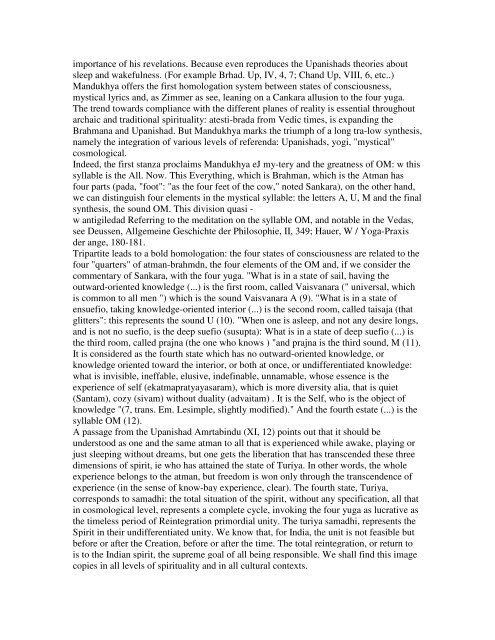Mircea Eliade YOGA IMMORTALITY AND ... - Brihaspati.net
Mircea Eliade YOGA IMMORTALITY AND ... - Brihaspati.net
Mircea Eliade YOGA IMMORTALITY AND ... - Brihaspati.net
You also want an ePaper? Increase the reach of your titles
YUMPU automatically turns print PDFs into web optimized ePapers that Google loves.
importance of his revelations. Because even reproduces the Upanishads theories about<br />
sleep and wakefulness. (For example Brhad. Up, IV, 4, 7; Chand Up, VIII, 6, etc..)<br />
Mandukhya offers the first homologation system between states of consciousness,<br />
mystical lyrics and, as Zimmer as see, leaning on a Cankara allusion to the four yuga.<br />
The trend towards compliance with the different planes of reality is essential throughout<br />
archaic and traditional spirituality: atesti-brada from Vedic times, is expanding the<br />
Brahmana and Upanishad. But Mandukhya marks the triumph of a long tra-low synthesis,<br />
namely the integration of various levels of referenda: Upanishads, yogi, "mystical"<br />
cosmological.<br />
Indeed, the first stanza proclaims Mandukhya eJ my-tery and the greatness of OM: w this<br />
syllable is the All. Now. This Everything, which is Brahman, which is the Atman has<br />
four parts (pada, "foot": "as the four feet of the cow," noted Sankara), on the other hand,<br />
we can distinguish four elements in the mystical syllable: the letters A, U, M and the final<br />
synthesis, the sound OM. This division quasi -<br />
w antigiledad Referring to the meditation on the syllable OM, and notable in the Vedas,<br />
see Deussen, Allgemeine Geschichte der Philosophie, II, 349; Hauer, W / Yoga-Praxis<br />
der ange, 180-181.<br />
Tripartite leads to a bold homologation: the four states of consciousness are related to the<br />
four "quarters" of atman-brahmdn, the four elements of the OM and, if we consider the<br />
commentary of Sankara, with the four yuga. "What is in a state of sail, having the<br />
outward-oriented knowledge (...) is the first room, called Vaisvanara (" universal, which<br />
is common to all men ") which is the sound Vaisvanara A (9). "What is in a state of<br />
ensuefio, taking knowledge-oriented interior (...) is the second room, called taisaja (that<br />
glitters": this represents the sound U (10). "When one is asleep, and not any desire longs,<br />
and is not no suefio, is the deep suefio (susupta): What is in a state of deep suefio (...) is<br />
the third room, called prajna (the one who knows ) "and prajna is the third sound, M (11).<br />
It is considered as the fourth state which has no outward-oriented knowledge, or<br />
knowledge oriented toward the interior, or both at once, or undifferentiated knowledge:<br />
what is invisible, ineffable, elusive, indefinable, unnamable, whose essence is the<br />
experience of self (ekatmapratyayasaram), which is more diversity alia, that is quiet<br />
(Santam), cozy (sivam) without duality (advaitam) . It is the Self, who is the object of<br />
knowledge "(7, trans. Em. Lesimple, slightly modified)." And the fourth estate (...) is the<br />
syllable OM (12).<br />
A passage from the Upanishad Amrtabindu (XI, 12) points out that it should be<br />
understood as one and the same atman to all that is experienced while awake, playing or<br />
just sleeping without dreams, but one gets the liberation that has transcended these three<br />
dimensions of spirit, ie who has attained the state of Turiya. In other words, the whole<br />
experience belongs to the atman, but freedom is won only through the transcendence of<br />
experience (in the sense of know-bay experience, clear). The fourth state, Turiya,<br />
corresponds to samadhi: the total situation of the spirit, without any specification, all that<br />
in cosmological level, represents a complete cycle, invoking the four yuga as lucrative as<br />
the timeless period of Reintegration primordial unity. The turiya samadhi, represents the<br />
Spirit in their undifferentiated unity. We know that, for India, the unit is not feasible but<br />
before or after the Creation, before or after the time. The total reintegration, or return to<br />
is to the Indian spirit, the supreme goal of all being responsible. We shall find this image<br />
copies in all levels of spirituality and in all cultural contexts.







